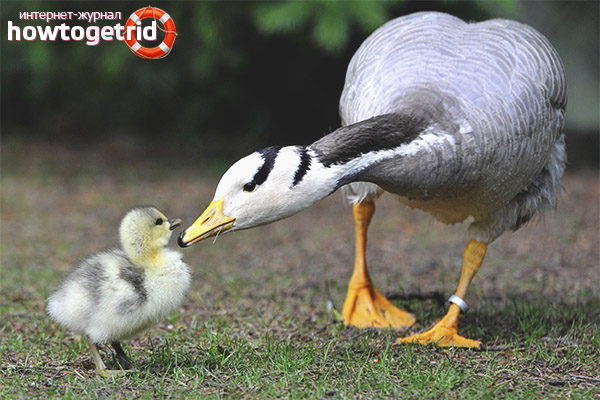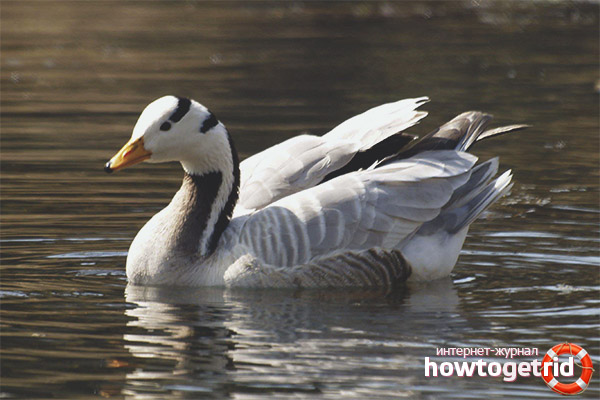The content of the article
Mountain goose is a medium-sized waterfowl that differs from other species of the family in its color (the body is light gray, the color of the plumage is white). The bird has rather long legs, although the goose moves on them rather awkwardly, can run fast, helps wings with movement, making small flaps.
In fact, the bird presented to attention prefers to lead a land-based lifestyle, however, this doesn’t interfere with it perfectly and feel in the water, as a rule, when a dangerous situation arises, geese choose the water bodies, which helps them quickly hide from the enemy.
Habitat
Mountain goose - the bird that is most common in Asia - its central part (a typical representative of the goose family of the Asian-Asian type). The distribution limits of the species in the north are Mongolia. In the warm period, the goose can often be found in the southern Baikal region. The main place of wintering of this species In India and Pakistan.
Biotope
Abundance of species
The highest populations of mountain goose live only in Tibet, in other areas of distribution the number of bird colonies is medium in size (with the exception of the Tien Shan - small groups of birds). I would like to note that in the past few decades, the population of such a bird species as mountain goose has declined markedly.
Propagation Features
The first time after the colony arrives at the nesting site, birds, as a rule, gather in small flocks, consisting of several tens of individuals. Already after some time, the birds from these groups are divided into pairs. Matrimonial games imply that the male begins to attract the attention of the female by air “catching up”, while making unthinkable pirouettes in the air.
Often the goose nests in small colonies (up to 10 adjacent nests). The place for the nest is selected on a small hill (ledges of rocks, fairly tall trees). A prerequisite for bird nesting is the presence in the immediate vicinity of the nest of a water source, which also implies wetlands.
Building a nest on a tree, a goose places it at a height of at least 5-6 meters from the ground. For construction, thin twigs and knots are used. Note that the nests of these waterfowls are distinguished by a peculiar sloppy construction and a shallow masonry tray.
The nests erected in the wetland represent small depressions in the soil, framed and lined with branches and vegetation. The bottom is abundantly covered with bird fluff.
The average number of masonry is from 6 to 8 eggs, the size is average, the surface is rough with a characteristic matte sheen. The emerging brood of chicks is constantly monitored by both the male and the goose. When danger arises, adults transfer the young to water, after which the whole family swims to a quiet and safe place.
Nutrition
The basic diet of a mountain goose is a variety of terrestrial vegetation growing on the banks of water bodies or at some distance from them. Most preferred for this type of bird cereal bread. Also, geese of this family often eat algae, invertebrates and crustaceans, found near the wave-striking strip and on the coast of water bodies.
Bird structure and size
The average body length of adult individuals of a mountain goose reaches 454 mm, weight - 2-3.2 kg. The beak of the bird is much smaller than the size of the head itself with the same width along the entire length and a slight rounding at the top. The length of the wings of birds reaches the top of the rounded tail, the latter has 8 pairs of tail feathers. Goose paws are quite short with a small middle finger. The back finger on the paw has a well-developed lobe.
Features of plumage color
The offspring of goslings born has a down jacket of saturated straw color, as well as a characteristic brownish-gray spot on the crown. The body color is mainly light olive, the lower back and wings are light yellow. The outfit of the grown offspring differs in that the body color darkens a bit, becoming light smoky. The color of the neck seems variegated due to the many white fluffs. The front part becomes white, and the sides get a white-smoky color.
The color of young birds is monophonic, gray, without transverse stripes characteristic of this species. The upper part of the body and the head are white. Dark gray spots on the crown of the head and nape. After the start of the period corresponding to the second molt, the color of the plumage receives easily defined transverse stripes. The mountain goose receives the final outfit after the third molt.
Molting features
The period of full summer molting of a mountain goose lasts from June to July. The earliest molting begins with representatives of this species living in Altai. As a rule, at the beginning of summer, the change of a feather begins, which is why individuals move exclusively on land. The geese stand on the wing only in the middle-end of August. Note that the change of plumage of adult birds coincides with the time of the beginning of growth of the first feather cover in young animals.
Full molting of an adult bird is characterized by the simultaneous onset of the loss of all the fly feathers, after which the plumage of the upper covering is dropped. Further, the change of feathers reaches the lower coverts. In the future, with the growth of a new feathering, a gradual change in the contour pen begins. I would like to note that the process of molting of individuals of a species often takes place in a shorter time interval than many northern relatives of this species of bird.
Economic value
Mountain geese are one of the most highly elevated birds in the air. During the migration period, when flying from India or Asia, they can literally cross quite large mountain ranges in just a few hours. These birds can fly without rest for at least 10 hours. This is due to the fact that at high altitude, blood carries much more oxygen into muscle tissue, which, in fact, distinguishes them from the nearest relatives of the goose family.
Thanks to unusual physiology, the mountain goose is able to make not only long flights, but also survive in the extreme conditions of the natural habitat.
Video: mountain goose (Anser indicus)












Submit